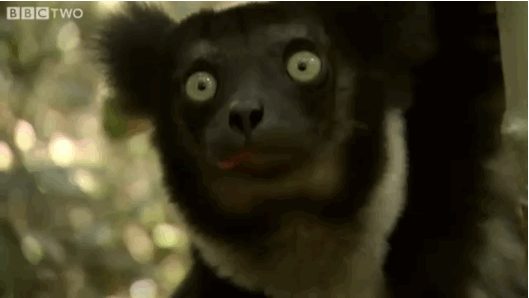

So, here are the rules: To answer, follow us on Twitter and tweet at us with the hashtag #mysteryanimal. For example:
Hey @PopSci, is the #mysteryanimal a turkey?
And then I might say “if you think that’s a turkey, perhaps you are the turkey!” But probably not, because this is a positive environment and all guesses are welcome and also this is not a very common animal so guess whatever you want!
The first person to get it right wins! We’ll retweet the answer from @PopSci, and also update this post so your amazing animal knowledge will be permanently etched onto the internet. Show your kids! Your dumb kids who thought that was a baboon!
Update: And the winner is…Seth Rosenthal, who correctly and in all capital letters guessed that this is an indri! The indri is a very large lemur, one of the largest in the world, in fact. It’s native to Madagascar, like all lemurs, and is closely related to the sifakas.
The indri, like the sifakas, stands vertically when grasping and leaping through the trees, where it spends all of its time. Its long, powerful legs are rarely fully extended except when leaping, but when they are, the indri can be nearly four feet tall. Its behavior is curious; it has many traits in common with humans, for example. It practices long-term monogamy and has very close nuclear familial ties. The young mature slowly, and stay with their parents for as many as 9 years–an extremely long time, in the animal kingdom. It’s also known for its detailed songs, which have specific movements, and can signify anything from “that’s a loud noise” to arranging territory with other families or noting when members of its own family are sexually active. (This is slightly different from humans–few human fathers are known to yell “MY YOUNG DAUGHTER IS SEXUALLY ACTIVE” at passersby.)
It also demonstrates what some call, and what biologists are very reluctant to call, “sun worship.” It’s really more like basking or tanning; it will sit and face the sun in a meditative position for hours.
As a result of its semi-human-like behaviors, the indri has a very special relationship with the Malagasy people, the natives of Madagascar. It’s protected by fady, or taboo–it cannot be harmed or eaten. There are many different legends, but they mostly all come back to the idea that the indri is sacred because it was at one point related to humans–that a human turned into an indri, or that two brothers quarreled and one became the first human and the other became the first indri, or that a father lost his son (or vice versa) and became an indri.
But colonialism and modernity have diminished the power of the fady, and the indri is endangered today, due to habitat destruction and some hunting. The indri has proved nearly impossible to breed in captivity, making its survival all the more difficult in Madagascar.
GIF pulled from this BBC video.
